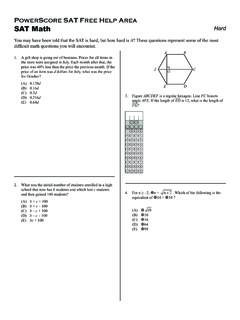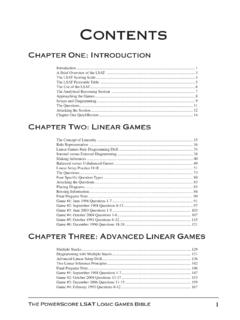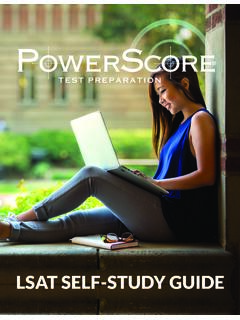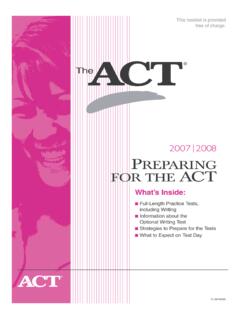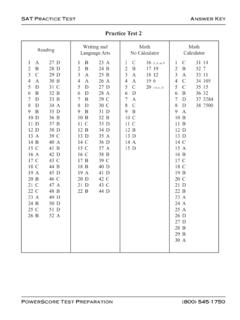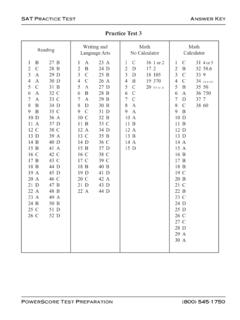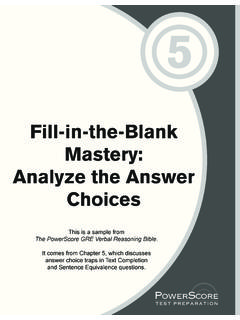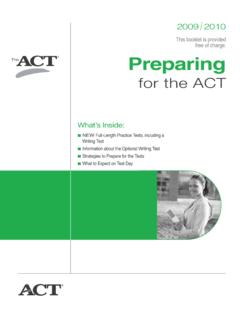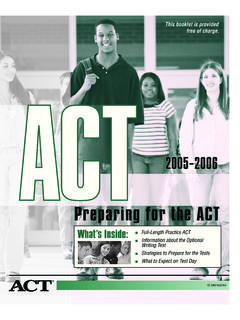Transcription of Chapter Ten: Data Analysis, Statistics, and Probability ...
1 Chapter Ten: Data Analysis, statistics , and Probability Mastery Unlike other standardized admissions tests, you do not have to remember a copious number of rules and endless amounts of material for the SAT. The College Board uses a finite number of skills to test your ability to reason critically. Therefore, the SAT math sections can be conquered given intense study and repeated practice. The more exposure you have to real SAT questions, the fewer surprises await you on test day. As we discussed earlier, much of the test content and many of the required skills are quite basic such as remainders or fractions.
2 You may find that some of the content review in the following chapters seems elementary and inappropriate to high school students. We urge you to read through it, however, as tips, tricks, and shortcuts are mentioned in the content area discussion. We often advise you to solve problems much differently than the ways you were previously taught, so skipping content can cause you to miss important information. Each content section (such as Counting Problems or Sequences) contains two parts: the Required Knowledge and Skill Set and Application on the SAT.
3 The Required Knowledge and Skill Set is a review of basic concepts and applications involving the content area. The Application on the SAT section examines how this basic content may be presented on the test. At the beginning of each content area, in the notes column near the edge of the page, is a frequency guide where the content is assigned a number. This number indicates the likelihood that this content will be tested on your SAT. Based on PowerScore's extensive analysis of real tests, you can use the following key to predict the general frequency of each question type: Rating Frequency A Frequency Guide is 5 Extremely High: 3 or more questions typically appear on every SAT.
4 Provided for every type 4 High: at least 2 questions typically appear on every SAT of problem so you can 3 Moderate: at least one question typically appears on every SAT prioritize the content you need to study most. 2 Low: one question typically appears on every two or three SATs 1 Extremely Low: one question appears infrequently and without a pattern Chapter Ten 397. Data Analysis, statistics , and Probability Mastery This book contains many examples and explanations of multiple-choice and student- produced response questions. It is important to understand how these questions are numbered throughout the book so that you can learn to judge a question 's difficulty.
5 All of the multiple-choice questions are numbered 1 through 20, just as they are on the longest multiple-choice section of the SAT. The first 5 to 7 questions are typically Easy and the last 2 to 4 are usually Hard. The questions in between have a Medium difficulty level. Keep in mind that question number 8 is probably easier than number 15, even though they are both considered Medium level questions. Examples of student-produced response questions are numbered 9 through 18, just as they are on the test. Questions 9 and 10 should be considered Easy, while those numbered 11 through 16 are Medium.
6 A question that is listed as 17 or 18 is Hard. Following each individual content review is a short problem set. An answer key Score increases are dependent upon is provided at the end of the Chapter , where each question is assigned a degree of repeated practice! difficulty. If you struggle with any Easy or Medium difficulty level questions, reread Be sure to complete the content section and then use the map to find additional practice questions in the questions in each the Blue Book Database, located on the book website ( Problem Set. satmathbible).
7 It is only through repeated practice that you can become confident with a specific question type. Remember that there are eight solution strategies you can employ on SAT math questions: 1. ANALYZE the Answer Choices The PowerScore SAT. 2. BACKPLUG the Answer Choices Solutions Strategies 3. SUPPLY Numbers are fully explained in Chapter Four. 4. TRANSLATE from English to Math 5. RECORD What You Know 6. SPLIT the question into Parts 7. DIAGRAM the question 8. SIZE UP the Figures Be sure to check your answers in the answer key following the Chapter . It is important to understand why you missed a particular question , in order to avoid making this same mistake on the SAT.
8 398 The PowerScore SAT Math Bible Data Analysis, statistics , and Probability Mastery The final math content area of the SAT includes data analysis, statistics , and Probability . Because many high school students have not taken a statistics course, Do not be intimidated by this section; we will they find these questions especially intimidating. However, these test takers make give you all the tools you ideal PowerScore students, as there are no bad habits to unlearn or excess information need to succeed! to disregard. You simply need to learn the concepts in this Chapter to be prepared to face any statistics or Probability question on the SAT.
9 This Chapter will explore the following concepts and explain how they are tested on the SAT: 1. Data Analysis 2. Average, Median, Mode 3. Counting Problems A. Combinations B. Permutations 4. Probability 5. Sequences 6. Overlapping Groups 7. Logical Reasoning Data Analysis, statistics , and Probability questions typically account for 10% to 20%. of the SAT Math questions. Understanding this content is essential to your success on the SAT, so be sure to tackle the questions in the Blue Book Database for extra practice upon completing the problem sets in this section of the book.
10 Good luck! Chapter Ten 399. Data Analysis, statistics , and Probability Mastery Data Analysis Frequency Guide: 4 Data analysis questions use diagrams, figures, tables, or graphs in conjunction with arithmetic and algebra. Required Knowledge and Skill Set 1. You must be able to read and interpret several graphs, including a pictograph, bar graph, pie graph, line graph, and scatterplot. A pictograph uses pictures to represent data: FISHING LICENSES SOLD IN METRO AREA BY COUNTY. = 1000 fishing licenses How many fewer fishing Beaufort County licenses were sold in Hamilton County than Clinton County?
